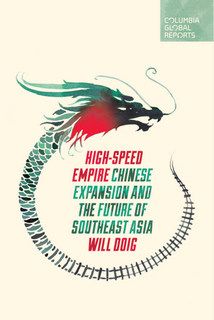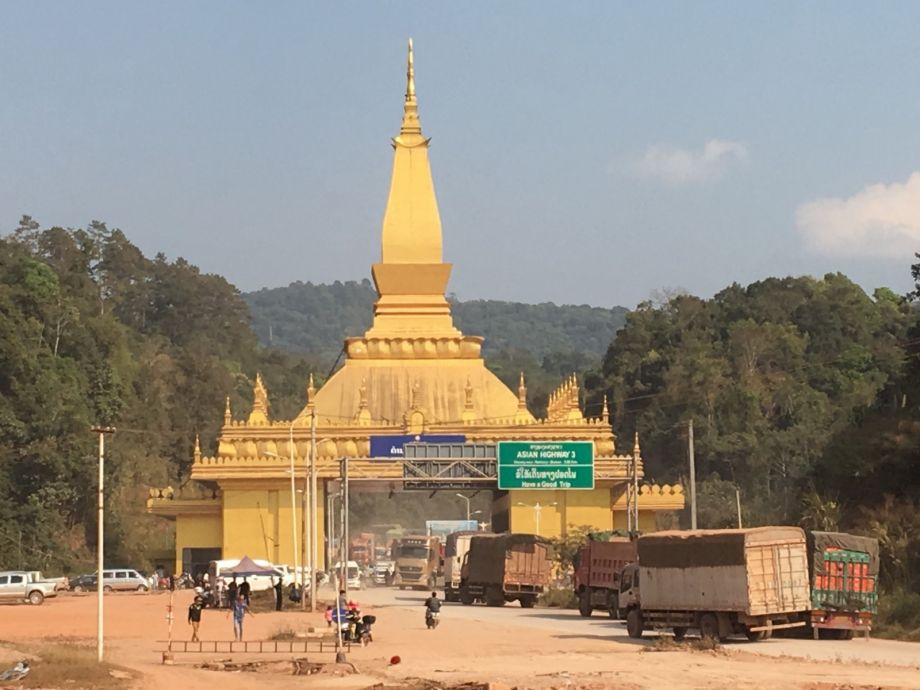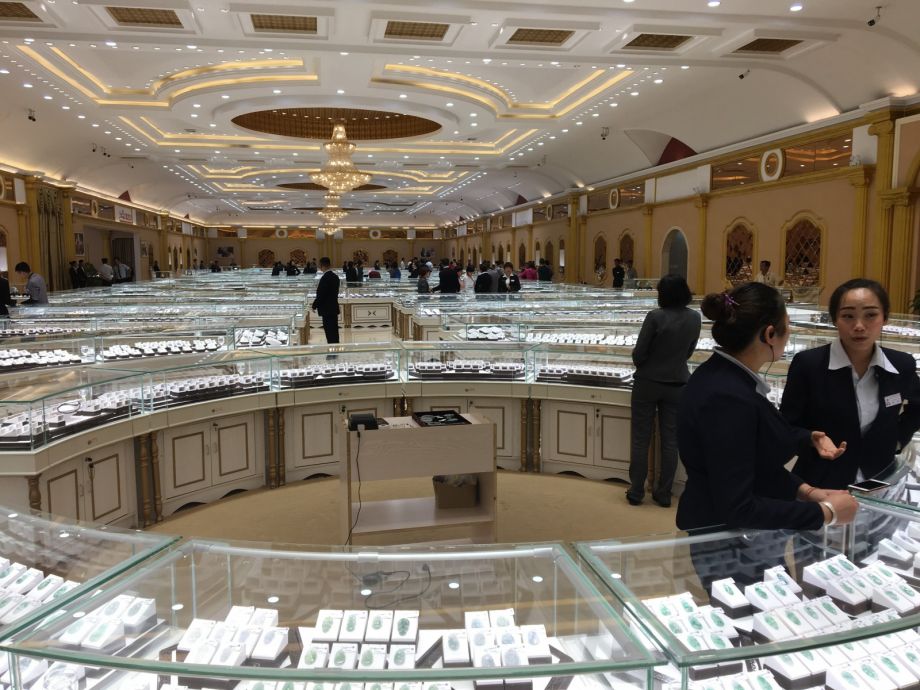Are You A Vanguard? Applications Now Open
Long-haul trucks queue up to enter Boten, Laos. As a border town, Boten has become a major transport hub for goods moving between China and Laos, and will soon be the entry point into Southeast Asia for China's railway.
Photo by Will Doig
This is your first of three free stories this month. Become a free or sustaining member to read unlimited articles, webinars and ebooks.
Become A MemberAuthor’s note: China’s “One Belt One Road” Initiative is an audacious plan to cover half the earth in Chinese-built infrastructure: railways, highways, shipping lanes, and energy corridors. One of the initiative’s marquee projects is a railway that China would like to build from its southern city of Kunming all the way through Southeast Asia to Singapore. Construction has just gotten started, particularly in Laos, the first Southeast Asian country the railway would run through. A poor and extremely undeveloped place, Laos has seen China’s presence grow quickly in recent years. I traveled to Laos in March 2017 while researching a book about the railway to see for myself how the project was coming along. What I found was surreal.

In the remote Laos-China border region, China is turning highland villages into teeming industrial hubs. Engineers have sliced modern highways — the kind you rarely see in Laos — through the jungle. And in one case, Chinese city-builders are resurrecting Boten, a former casino town that had been abandoned years prior, retrofitting it to serve as the railway’s entry point into Laos. This chapter-length excerpt is a snapshot of this isolated region and its dramatic transformation, as China begins its inexorable march with steam shovels, blueprints and big plans for the future.
Some sixty miles south of the Chinese border lies Oudomxay, a gritty staging site in northern Laos for heavy industry and a transport hub for regional cargo flows. Twenty years ago this was a highland village, but its population has ballooned to about 25,000 as Chinese entrepreneurs have settled in. Now it’s filled with auto dealerships selling steam shovels and street vendors hawking sheet metal. In one shop, I watched an elderly man puff on a PVC pipe that had been turned into a bong. The Sheng Chang Hotel, a six-story palace of purple and gold that’s the only glamour to be found in Oudomxay, is largely empty, and the darkened floors above are lit only by glowing blue doorbells that line the halls like runway lights. The hotel’s only apparent staff, a Lao receptionist, says the few guests they receive are Chinese project managers, but that they expect to be fully booked before long. Oudomxay will soon have a railway station.
The Sheng Chang sits on one side of the Nam Ko River, which runs along the western edge of town and nourishes a collection of rice paddies that stretches toward the horizon. One of these paddies belongs to Somphone Phomexay, a soft-spoken hydroelectric engineer who was sent to Oudomxay from Vientiane in the 1990s to help build the nearby Nam Ko River Dam. He’s worked at the dam ever since, while harvesting rice and fruit trees to supplement his income.
One day in the late summer of 2016, Somphone’s village chief asked him and seven of his neighbors to come to a meeting with a poker-faced government official. “The chief explained that our fields would be reclaimed as the site of the railway station,” says Somphone. “Then the official helped me fill out an application for compensation.” Somphone dutifully filled out the paperwork and handed it over. Shortly thereafter, a team of Chinese surveyors trundled through his rice paddy, measuring the land.
Somphone’s field is part of a rare spit of level land in a province characterized by craggy mountains and misty valleys. It’s some of the most rugged terrain on earth, and the railway will run straight through it. An elevation diagram of the route resembles a cardiac patient’s heart rate, zigzagging up and down through Northern Laos before flatlining along the plains in the south. The route will require more than 150 bridges and 70 tunnels. Seven of these tunnels will be more than four miles long. The mountains are unstable limestone and the area the railway will run through is littered with unexploded ordinance left over from the 270 million bombs dropped on Laos by the U.S. during the Vietnam War. It’s enough to cast doubt on whether it will ever be built.
And yet, signs of something coming are apparent. Earthmovers sit atop tracts of freshly leveled land all along the roadside from the border to Oudomxay. Chinese workers in blue and white uniforms squat and smoke by aluminum-clad roadside dormitories, their facades sporting royal blue banners marketing the project in Lao and Mandarin: China Railway Number 5 Engineering Group, Boten-Vientiane Railway Section, Department of Construction Management. Number 1 Concrete Mixing Plant Welcomes You. Building the Laos-China Railway. Bringing Benefits to the Lao and Chinese People.
Some of the laborers living in these dorms will presumably work at the new cement plant further up the road, just outside the village of Nam Veun. Blue and white silos tower over a billboard celebrating the plant’s inauguration, and you can find similar silos downstream from Oudomxay, where the energy company ChinaPower is building a large hydroelectric dam. It’s the latest in a string of dams China has constructed on the upper Mekong River. Since the Lao government opened the power sector to foreign investment in 1993, hydroelectricity has become one of Laos’s primary exports.
Everything related to the railway, from the cement plants to the workers’ jumpsuits, is branded with the same blue and white color scheme and emblazoned with Mandarin characters. It sets them far apart from the rest of the town, visually and geographically. The Chinese generally “prefer to live together in their own circle and are not so sociable with their fellow local employees,” as a 2012 memo put out by the Chinese embassy in Nairobi bluntly stated.
Sharing a meal with my fixer, Seng, at a roadside restaurant in Oudomxay. The experience of eating at a Lao-owned establishment is a lazy affair of chit-chat and pleasantries.
On the way to Boten we took a wrong turn — not easy to do in a country with so few roads, but we managed. We ended up in a threadbare village called Nateuy. A group of women was sitting on the side of the road and we stopped to ask directions. They were getting plastered on domestic beer in the early afternoon sun. When I told them why I was in Laos, they groaned in unison. The Chinese were everywhere now, and rude, they said. One of them had even opened a small restaurant without talking to the local village chief first, which the women took as a sign of disrespect. “They just do what they want because they have power,” said one of them, wielding her beer. “They just come here and make money.”
We stopped at the restaurant they’d complained about. The proprietor ushered us past a row of glass jugs filled with roots and dead turtles floating in clear liquid. We were the only customers, but she seemed impatient for us to order. Photographs of meals were posted on the walls, and she led me by the elbow from photo to photo as if in a gallery. Spicy mapo tofu and rice arrived quickly, and she stared as we ate. It was not at all like the experience of eating at a Lao-owned establishment, a lazy affair of chit-chat and pleasantries. I could see how the rift in cultural norms would leave the Lao feeling disrespected.
A half-abandoned former casino town in the Lao jungle is not where Callan Cheng imagined he’d be living at twenty-nine. Yet here he was in Boten, huddled beneath an umbrella, exiting the shopperless duty-free mall, where he worked as a buyer in a nondescript office high above the aisles of perfume and whiskey. It had been raining for a week straight, and though his apartment building was only a five-minute walk from his office, the slog from work to home through the muddy streets was a daily depressant.
At least Cheng lived on the fifth floor. The first and second floor flats devolved into moldy, moisture-locked terrariums when it rained for days on end like this. He even had his own room — one of the rare perks of middle management — a budget-motel motif of hard-tile flooring, bare walls, and shiny lacquered decor. He’d been living here since 2014, when he was hired by the Boten Economic Zone Development and Construction Group, a Chinese company headquartered in Kunming. From there, Cheng’s company manages the city of Boten remotely. “We control all of Boten, the entire city,” he says. In effect, the company is the municipal government, administering Boten’s taxes and finances, public utilities, telecommunications infrastructure, sanitation, emergency services, its hotels, markets and, of course, the duty-free mall. Likewise, nearly everyone working in Boten is on the company payroll. The Lao public sector has minimal involvement. “They’ve authorized us to take care of things,” says Cheng.
When the border crossing was established in Boten in 1993, this region was a thinly settled terra nullius of scattered, isolated mountain settlements. In the early 2000s, the arrival of the casinos turned the city into a braying haunted carnival, but with the focus on illicit fun it didn’t really develop as a trade hub. In 2009, a paltry $20 million in Sino-Thai commerce moved through here. A diplomatic cable from that period described it as a “remarkably quiet border crossing…with one truck and one bus coming into China” over the course of half an hour.

Trucks that have made their way through Boten rumble toward the Chinese border, after which they'll follow a new highway into Yunnan Province and points north. The gold Buddhist stupa that marks the entrance to China looks similar to one in the Lao capital of Vientiane, and was apparently built by the Chinese as a conciliatory gesture for essentially taking over the city. (Photo by Will Doig)
A decade later, with boring machines slicing a new railway tunnel across the border and trade between China and ASEAN approaching half a trillion dollars per year, Boten is reincarnating, bit by bit, as a commercial hub—a transport link for China into Southeast Asia, and a One Belt One Road priority holding. You can see offshoots of the city’s new relevance in the wilderness just beyond its borders, where flashes of alien modernity have materialized: PetroLao gas stations, stucco guesthouses, and the weirdest: a palatial furniture showroom fully stocked with flashy bedroom sets. Sections of the forest have been clear-cut to make way for muddy parking lots filled with flatbed trucks.
At the entrance to Boten is a customs checkpoint, confirmation that you’re exiting Laos without actually leaving. Beyond the checkpoint, the jungle torpor immediately evaporates, replaced by a grinding, gridlocked sea of long-haul trucks fighting their way toward the Chinese border. The queue of traffic bypasses Boten’s mostly empty core. From afar, in the midday haze, Boten’s pastel skyline could pass for a faded Florida resort town. Up close, it looks like what it is: a city slowly regenerating after a population crash.
Around town, some of the former enterprises have been revived. Cheng’s cavernous duty-free mall, once a disco, contains Marlboros and Johnnie Walker, but virtually no customers. Young Chinese clerks in sharp black suits wander the quiet aisles like docents in a pop art museum.
Down the street, at the Royal Jingland Hotel, the courtyard fountain is filled with muck, and overgrown tropical gardens are climbing the building’s exterior walls. A rusting Yamaha motorbike lies in a weedy flower bed, and one of the electric trams formerly used to shuttle guests around town rusts out on four flat tires. In the lobby, the air is cool and moist. There’s a chunk missing from the hotel’s back wall, and the gaping hole frames the forest beyond like a diorama of prehistoric life. Most of the rooms are sealed, but a few have been broken into, including one with rumpled bedding on the mattress and the remnants of a nonpaying guest’s recently eaten meal. In a third-floor solarium, damp shirts dangle from hangers on a ceiling pipe, drying in the sun. A ransacked supervisor’s office is strewn the minutiae of hotel management: employee schedules, reports typed up in Mandarin, and a Chinese-English dictionary opened on the desk, as if its owner looked up a word, left the room, and never returned.
One of Boten’s few hotspots is in the former Golden Casino, readapted as a luminous jade emporium buzzing with a deal-seeking Chinese clientele. A security guard hesitates to admit the unshaven Westerner in the dirty black t-shirt, but a young shopgirl bounds to my rescue: Wang Tingting from Yunnan Province. She strides toward me, arm outstretched, grinning like an old friend. Where do I come from? New York! How exciting! What am I doing in Boten? A book! Interesting! She spirits me inside, muttering something in Mandarin to the guard as we enter before turning to me and playfully rolling her eyes as if to say, “Can you believe that guy?”
With the polished affability of a corporate publicist, Wang whisks me through the marketplace. Thousands of bracelets, necklaces, rings, and amulets glint beneath LED lights, all of them carved from jade mined in Myanmar’s conflict-riven Kachin State. “Only the best minerals,” Wang assures me, “and something for every ability to pay.”

A jade emporium in Boten, housed in one of the city's former casinos. Boten was once a raucous gambling town for Chinese tourists, but its rebirth as a transport hub has spawned more import-export oriented businesses. (Photo by Will Doig)
Wang has a wanderer’s soul. In her early twenties she moved to Thailand, fell in love with the country, and ended up spending several years there. “I speak Thai, and I want to go back and use it,” she says. Six months prior to our meeting she had moved to Boten, hoping to cash in on the boom she believes will inevitably arrive with the high-speed railway. Getting the go-ahead to work in Boten wasn’t hard, she says, thanks to the cross-border cooperation pact that expedites permissions for Chinese nationals who want to work here.
The ease with which Wang got the job in Laos is exactly the point of a special economic zone (SEZ): to eliminate the red tape that delays getting down to business. “For investors, SEZs create a one-stop shop that simplifies their lives by not making them deal with every single government department separately,” says Vicky Bowman. “It gives them a sort of protected first-class treatment.” But as Wang Tingting proves, even a humble store clerk can leverage the perks of an SEZ. “Once the railway is built, this will be an important place to work,” she informs me.
Cheng agrees that those willing to spend a few years here will eventually be rewarded. “I don’t like living in Boten,” he says. “It’s too deserted for me.” He hopes to someday return to the cacophonous clang of Kunming, where he was raised an only child in the modern Chinese tradition. Or better yet, glitzy Shanghai, his city of dreams. For now, however, he’s biding his time. “I think in five years, Boten will be a big city,” says Cheng. “Not huge, but better than now. I think there will be over 100,000 people, tourists, people doing business. It’s the first station on the railway for Chinese people going to ASEAN, so it will be important for logistics. I want to have a chance to be part of its development.”
In the city center, this development is beginning to take shape. A trio of poured-concrete towers, the fledgling skyline of the renovated Boten, rise amid a tangle of cranes. According to Callan, the redevelopment plan calls for a total of six downtown buildings that will constitute some form of miniature central business district. Some of these buildings can be seen in renderings posted at the construction site: the tawdry sin city has vanished, replaced by a bright, wholesome streetscape of boulevards and cafés.
Boten is sketched as originally sold: a most internationally modernized city, now in development by a Chinese consortium under a reported ninety-nine-year concession. “The anarchy of the border country is, for those with the capital and connections and ability to exploit it, a giant opportunity,” writes Ben Rawlence in the book City of Thorns. For Boten’s new opportunists, the fledgling logistics hub promises this and more: the chance to cash in on a massive global trade initiative at one of its most promising frontiers.
That frontier’s future is depicted on glossy flyers stacked by the unmanned cash registers at the duty-free mall, with renderings of the new-and-improved Boten, a happy city with a high-speed train. In the center of the flyers is a photo of President Xi, and below him, a map of the world. Dotted lines lead outward from China to points throughout Asia, Europe, and Africa. The cities key to making One Belt One Road a success are marked with stars: Singapore, Mombasa, Tehran, Colombo, Moscow, Rotterdam, and a tiny city in northern Laos, perfectly placed on the route of a high-speed railway, its location labeled in Mandarin and marked with the biggest star of them all.
Excerpted from High-Speed Empire: Chinese Expansion and the Future of Southeast Asia, published by Columbia Global Reports.

Will Doig was formerly Next City’s international editor. He's worked as a columnist at Salon, an editor at The Daily Beast, a lecturer at the New School, and a communications staffer at the Open Society Foundations. He is the author of High-Speed Empire: Chinese Expansion and the Future of Southeast Asia, published by Columbia Global Reports.

20th Anniversary Solutions of the Year magazine